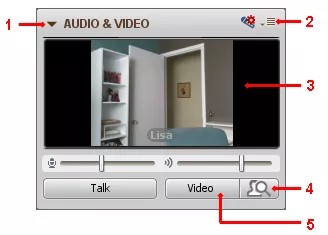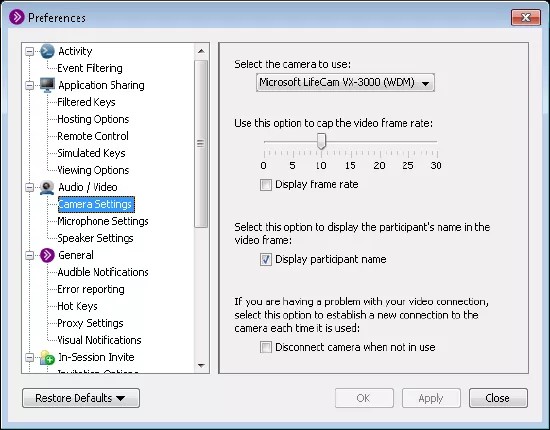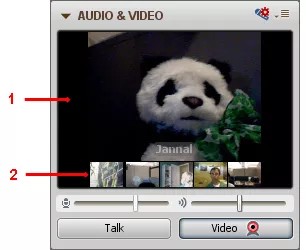Participants can use video cameras or web cams to transmit live videos during a session. Moderators can use the multimedia feature to play prerecorded videos.
The video feature works best for video with little movement, such as when you talk into your camera. In general, more movement requires a higher frame rate to prevent jerkiness or blurriness of the image.
The video feature can display up to six simultaneous camera transmissions. To learn more, see Multiple Simultaneous Cameras.
This feature is not supported on mobile devices.
Audio & Video Panel
In the interface, audio and video share a panel.
- Expand/Collapse
- Options menu
- Primary video display, with name of user transmitting video
- Preview video
- Transmit video
If the video function appears grayed out in your Audio & Video panel, you do not have permission to transmit video. However, you can view video transmissions, change your video display, preview your own video, and set your camera preferences.
Activity, Permissions, and Status Indicators
In the participants list, you can monitor the state of video activity, permissions, and status through indicators described in the following table.
| Activity Indicator | Description |
|---|---|
| User enabled a video camera. | |
| All users have the video permission. However, the moderator revoked this user's video permission. | |
| User has the video permission, but the moderator did not grant it to all users. | |
| User is experiencing a delay in receiving video. |
Example
- Vivian is transmitting video.
- Charlie is experiencing no issues receiving video.
- Lisa is experiencing a moderate delay in receiving video.
- Lucy is experiencing a significant delay in receiving video.
Select a Camera
If only one video camera is installed on your computer, Blackboard Collaborate automatically uses it when you preview and transmit video. However, if you have more than one video input device on your computer, you can choose which device to use.
Blackboard Collaborate remembers your settings for all sessions you join on the same computer.
When a connection is established to a video camera device, that connection is maintained until a different device is connected or the session is terminated. While a connection exists to a video device, that device is not available for use by other applications.
Use the following steps to select a camera:
- Open the Preferences window:
- From the Edit menu, click Preferences (Windows).
- From the Blackboard Collaborate menu, click Preferences (Mac OS X).
- In the left panel of the Preferences window, click Camera Settings in the Audio/Video section.
- Select a camera from the Select the camera to use drop-down list.
Multiple Simultaneous Cameras
Moderators can allow the transmissions of up to six video cameras simultaneously. Alternatively, they can disable multiple simultaneous cameras by setting the maximum allowed to one.
With more than one camera enabled, one video appears in the primary video display. Up to five other transmissions appear as thumbnails below the primary display. To learn more, see Control Primary Video Display.
- Primary video display
- Thumbnails
Using Video
To view the video transmitted by others, your primary video display must be open. If it is collapsed, click Expand. If you do not want to view video, click Collapse.
- Expand/Collapse
- Primary video display
- Name of user transmitting video
If you collapse your primary video display, you do not receive incoming video. This reduces the bandwidth used and improves the overall responsiveness of Blackboard Collaborate. When you transmit video, collapsing your video display does not affect bandwidth, and your video transmission continues.
Preview Video
Before you transmit video, you can preview it to check the quality. You can adjust your camera settings or change the video frame rate.
To see what others will see, click Preview video next to the Video function. After activation, the images captured by your camera appear in your primary video display, along with the word Preview. You are the only one who sees what appears. To stop the preview, click Preview video again.
- Preview image
- Preview video
If you receive an error while trying to preview video, such as Cannot connect to the video source, another application may be using your camera. Also, check if you selected the correct camera. To learn more, see Select a Camera.
Transmit Video
If the Video function appears grayed out in your Audio & Video panel, you do not have permission to transmit video. However, you can view video transmissions, change your video display, preview your own video, and set your camera preferences.
To transmit video, click Video. A camera icon appears, and participants can see your transmission. Click Video again to stop transmitting.
Control Primary Video Display
Participants and moderators can control the primary video display in the Audio & Video panel options menu in the following ways:
Video Follow Moderator Focus option-default is off
Moderators can use the Make Video Follow Moderator Focus option to force everyone to see what the moderator sees in the primary video display. This option overrides all other methods to control the primary video display.
Make Video Follow Speaker option-default is on
When Make Video Follow Speaker is on and a moderator has not enabled the Make Video Follow Moderator Focus option, the primary video display shows one of the following:
- You see the profile picture of the person speaking.
- You see the video transmission and the name of the person speaking.
- If no one is speaking, you see the profile picture of the last person to speak, even if that person has left the room.
The moderator option Make Video Follow Moderator Focus always overrides this option.
Manually select what to display
If the first two options are not enabled, you can manually control what appears in your primary video display. To move a thumbnail image into the primary video display, click the thumbnail. The image that was originally in the primary display moves to the thumbnail. The images swap places.
If you record a session with multiple simultaneous cameras, you cannot choose whose video stream to display in the primary video display.














